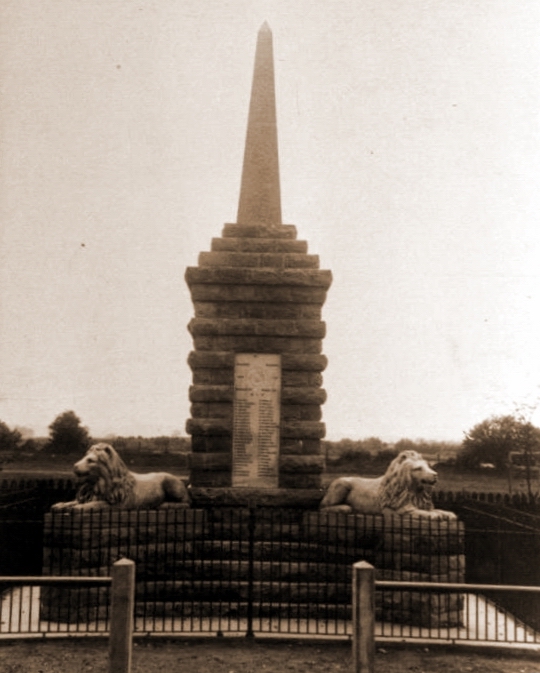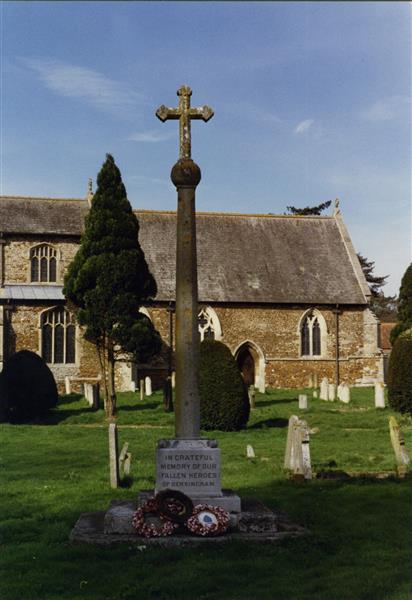It was shortly after the Armistice had been declared in 1918 that a meeting took place between the Trustees of Dersingham United Charities and the vicar the Rev. Lewis about erecting a memorial to all the men who had lost their lives in the conflict. The first question to settle was the site. There was some support for placing it in the churchyard but finally it was decided that the most fitting place was in the corner of the recreation ground by the crossroads. It would be from there that the men would have their last sight of the village as they marched down to the station at the start of their journey to war. For some it would indeed be their last sight but it would also be the first sight of their home for those who returned. As a compromise it was agreed that a memorial would also be placed in the churchyard. Then a discussion took place as to what form the memorials should take. A simple stone cross was decided for the churchyard but for the main memorial at the crossroads the design of a Latin cross on an orb, atop an octagonal column on a square plinth with a three stepped base was accepted.
In December 1918 letters and plans for the memorial were sent to the Charity Commissioners. In April 1919 the Trustees consented to the erection of a war memorial on the recreation ground and they undertook the upkeeping of the fences and seats. However the vicar and Mr. Firth the Clerk of the Trustees thought that none of the costs should be borne by the Trustees. In July of that year The Charity Commissioners suggested that responsibility for the recreation ground should be transferred from Dersingham United Charities to the Parish Council. In November the Trustees decided to object to the overburdened ratepayers being saddled with the upkeep of “what may prove a fragile memorial.” Subsequently responsibility for the recreation ground was taken over by the Parish Council.
Reports in the Lynn News
Jan. 17th 1920
The oak panels bearing the names of the 12 Dersingham men who fell in the war will be placed in position in the church shortly. The panels have been made by Mr. Walden and the names have been painted in red with gilt capitals by Mr. Linford.
Feb. 7th 1920
It has been decided to gild all the lettering of the names on the two memorial tablets placed in the church last week. The gilding originally was restricted to the initial letters.
April 17th 1920
This article reported that the dedication of the War Memorial tablet in the church had taken place. There was a brief description of the triptych and that on the table in front of it was placed the crucifix and candlesticks given by Queen Alexandra.
The report continued, “The North wall of the church has been panelled with oak 5 feet high and on narrow ledges are the portraits of the fallen with vases and flowers placed there by relatives.” (see the photograph at the end of this article)
At the opening ceremony there was a large attendance. After the hymn “Let Saints on earth in concert sing” the Rev. Lewis, preceded by the cross bearer, went to the monument and dedicated it. “To the Glory of God and in memory of all those who gave their lives for us in The Great War.”
The vicar, the choir and the congregation then processed to the memorial cross in the churchyard where everyone joined in the hymn “Through the night of doubt and sorrow” Following a lesson read from the bible the Vicar gave an address.” The State of the Departed” and concluded with the blessing.
It is intended to make the service here an annual event on Low Sunday.
The Village War Memorial Unveiled
The memorial at the crossroads was unveiled by the Mayor of Lynn Mr. Holcombe Ingleby.
The reporter described the Memorial and listed the names of the fallen that were inscribed upon it.
There was a large attendance at the ceremony. Mr. F.J.Tuck, Chairman of the Memorial Committee presided supported by Mr. & Mrs. Ingleby. The Rev. A.R.H. Grant, (Sandringham) and the Rev. F. Pritchard (Hunstanton) who had both served as chaplains to the forces were present with Mrs. Grant, Captain F. Brown, J. Chambers, G. Dodman, R.H.Stanton, F. Wills and R. Daniels as the other persons recorded.
Mr. Tuck opened the proceedings by commenting on the design of the memorial. The two lions were symbolical of Great Britain guarding the names and memory of her heroes.
It was hoped the obelisk on the top would only be temporary as they hoped to replace it with the figure of a soldier in full equipment.
Although all the panels containing the Roll of Honour were not yet in position they thought it better to unveil the memorial as they had the tablet with the names of the fallen rather than wait indefinitely for the others which would bear 240 names.
Mr. Ingleby said he was greatly honoured to be invited to unveil the memorial. At Ely recently he had met two young Americans who going to Dersingham to visit their fathers’ graves and to see the place from which they came. He was sure there would be many such visits in the future. He had heard people ask, “Why waste money on bricks and mortar? Why not do something more beneficial?” To that he would say that it was surely a proper act to make a sacrifice to commemorate those who had made the supreme sacrifice and not merely to erect something that would benefit ourselves. It should be remembered also that the money spent did not go out of the country and the country was not made poorer. When he was an M.P. he had assured the men who enlisted that their dependents would be cared for and that in the event of them making the great sacrifice their memory would not perish with them. It might be asked, “What’s the use? These poor fellows are dead and gone.” But it would be something to be able to say to the bereaved that we honour your sons for their gallantry and that they have made these sacrifices. And they could show that feeling by perpetuating their memory for all time. Mr. Ingleby then drew aside the Union Jack which covered the tablet bearing the names of the fallen. Following a closing prayer by Rev. Grant the National Anthem was sung and Mr. Loose then sounded “The Last Retreat”
A photograph depicting the War Memorial after the unveiling is at the end of this article.
After 1945 another 19 names were added of those who had lost their lives in WW2 with the names of all who had given service at home and overseas.
The memorial was restored by public subscription and funding from the Dersingham and King's Lynn Borough Council. After much delay it was announced in Dersingham Village Voice No 56 in February 2009, "Most of us will have noticed that work on the War Memorial garden is progressing well and that wooden sleepers have been put down to create raised planting beds. Councillor Houston, who is project managing the work, told the council that, weather permitting the job should be finished by the end of January after which a re-dedication ceremony of the Memorial was a possibility." Finally in Village Voice No 57 (April 2009) a report read,
"ROYAL BRITISH LEGION - MEN’S SECTION
May 9th 2009 (saturday), We will be attending the rededication of the War Memorial & V.E.Day Celebration under the auspices of the Dersingham Parish Council. For those wishing to attend, the service will be held at 12 noon and taken by Rev Michael Brock. There will also be refreshments laid on etc. so please come along and see the new Memorial Garden."
Each year services are held, and wreaths are laid, at the cross in the churchyard (see below). This is followed by a ceremony at the War Memorial which is at the crossroads of Lynn Road, Hunstanton Road, Station Road and Chapel Road. Perhaps this year (2017), and in years to come, we will remember the only civilian fatality in Dersingham as a result of an action of war - Mrs. Violet Ellen Dunger who died on 21st September 1916 following a bomb that was dropped on Doddshill on the night of 2nd/3rd September 1916. Read more in Darkening Skies - Zeppelin Attacks on Dersingham 1915 and 1916




